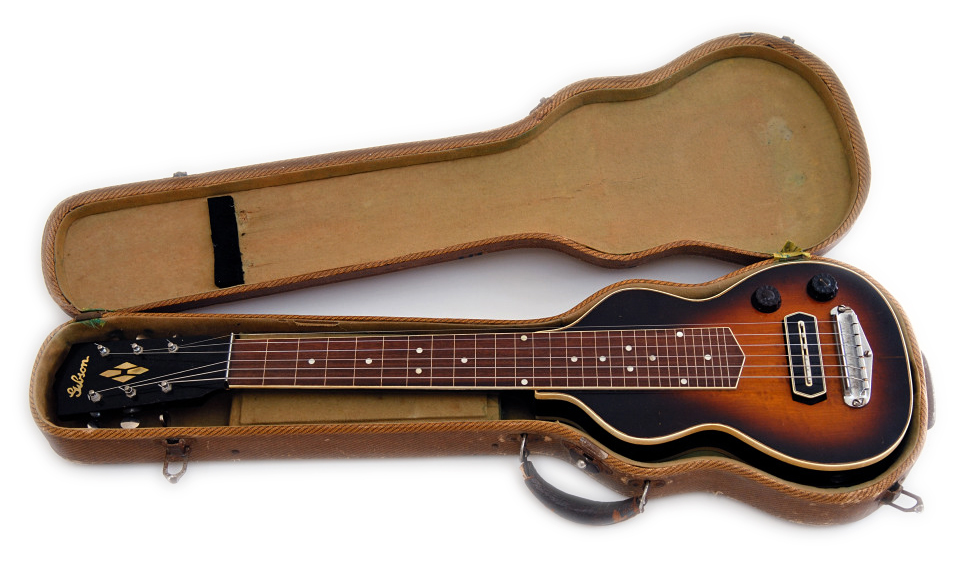Before collectibility and value can be determined about a Gibson guitar (and before you emailme asking, 'what kind of Gibson guitar do I have?'),several things need to be identified:
- The type of guitar (flattop, archtop, solidbody, lapsteel, etc).
- The exact model within the type.
- The year it was made (or approximate year/era).
- Oringinality (have any of the parts been changed or modified?).
The Skylark was Gibson's student model lap steel. Hence the numbers on the frets (similar to the Fender Champ). Skylarks are considered pretty cool today because of the Korina body and the awesome Gibson logo on the headstock.
First Determine the Type of Guitar and the Model.
Sometimes there is a tag inside the guitar stating the 'style' or model.If the model is hollow, look on the inside for any tags and madenote of any ink stamps (sometimes the model is ink stamped inside the guitar).But unfortunately, especially on the low to mid line models,usually there is NO tag or label inside the guitar specifying what it is.If this is the case, start at the beginning and first determine whattype of guitar you have.These are several different types of Gibson guitars made.Once this is known, go directly to the section aboutthat type (listed in the blue table of contents text above),and look at the model pictures and descriptions that matches your guitar.
National Lap Steel Serial Numbers
Here are the general types of Gibson guitars:
- Electric Solid body Gibsons: body is a solid piece of wood(no soundhole or cutouts), 1.5' to 2' thick, pickups and knobs routed into the top of the guitar.
- Flattop Acoustic Gibsons: single round sound hole under the strings, body 3.5' to 4.5' thick with a flat top, usually not electric(but often owners add a sort of bolt-on electric assembly).
- Acoustic Archtop Gibsons: two 'f' hole stylesound holes cut in the top, body 3' to 4.5' thick, slightly arched top, acoustic with no pickups (but sometimes these models have bolt-on electic assembly added later by players).
- Electric Archtop Gibsons: same as above ('f' holes, arch top)but the factory installed electric pickups into the guitar with volume/tone knob(s).
- Electric Thinline Archtop Gibsons: same as above (electricwith two 'f' holes in the top), but the body is thinner at 1.5' to 2' thick. These are always electric from the factory.
- Electric Lapsteel Gibson: a small solidbody guitar (no cutoutsor sound holes) that is playedin the lap, Hawaiian style, with a metal slide bar, pickup and knob routed into the top.

Once the type of guitar is determined, figuring out the exact model isMUCH easier! (just go to one of the above six linked webpages that describes your guitar, and compare each model specs to your guitar, until you find the one that matches).
Vintage Gibson Lap Steel
Next Determine the Year or Approximate Year.
Gibson guitars usually have a FON (Factory Order Number), a serial number, or both(but sometimes neither!) Various serial number systems were used by Gibson,and often the same serial number could be used in the 1950s, 1960s, and 1970s.See the serial number/FON section for details.Duplicate or no serial/FON number doesn't make things easy, but there are other traits that allow theserial number to make sense (see the General Specs sectionfor more details). Also mid to top end instruments usually have a label insidethe guitar with the serial number. Guitars with no label are usually lower end instruments(or are a solidbody guitar!)
Probably the first thing when trying to determine the year on an old Gibsonis whether the guitar was made 'pre-WW2', during WW2, or 'post-WW2'. This is easy to do, as Gibsonused different peghead logos for pre-WW2, 'wartime', and post-WW2 (see the General Specs section for more details). Knowing the general era of the Gibson guitar will make Gibson's rather complicatedserial number/FON systems less tangled.
Next Determine the Exact Model.
There are several general questions which can be asked in determining a guitar's model,once the type of guitar (flat top, arch top, etc.) has been determined:
Gibson Serial Number Guide
- What is the color of the top of the guitar? Common top colors include 'sunburst' (a yellow center that fades to a darker red or brown around the edges),black, natural and 'cherry red' (a translucent red which shows the wood grain).
- What is the color of the back of the guitar? Common back colorsinclude translucent dark brown, translucent light brown, sunburst, cherry red, etc.
- What is the body size? (measure the guitar across the top at the widest point, which isthe guitar's 'hips'). This is really important for all model types except solidbody electrics.
- What is the style of fingerboard inlays? (dots, blocks, trapezoids, double parallelagrams, etc.)
- What is the style of 'Gibson' peghead logo? That is, is it white silkscreen,gold silkscreen, or pearl inlay? Also if the logo is pre-WW2, wartime, or post-WW2 (see above).Also fancier models can even have some sort of pearl inlaid decoration (a 'crown' or longskinny 'diamond') on the pegheadjust below the 'Gibson' logo.
- What is the style of binding? Binding is the whitish/yellowish/tortoise 'band' that goesaround the edges of the body. Most Gibsons have some sort of body binding.Often binding is multi-layers (white/black/white, etc).Some guitars also have binding on the neck. The more binding a guitar has, the fancierthe model.
Gibson Lap Steel Identification
Finally Determine the Originality.
Originality of an instrument is very important. Modifications (any modifications),are a bad thing in the eyes of a collector. This will greatly influencevalue. Modifications can often be determined by looking at the modelspecs for a particular year guitar in this web page (after the approximate year is determined), and compare to your instrument.
Comments are closed.